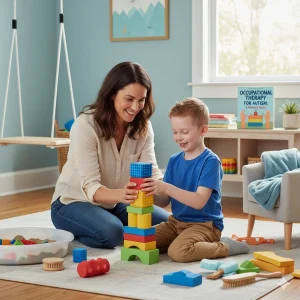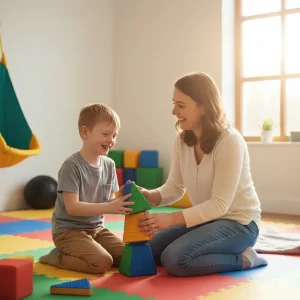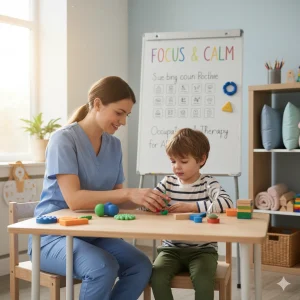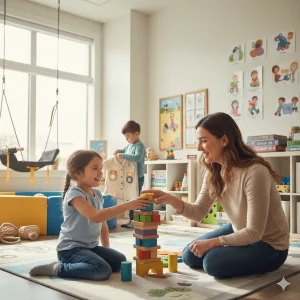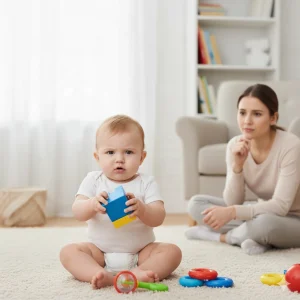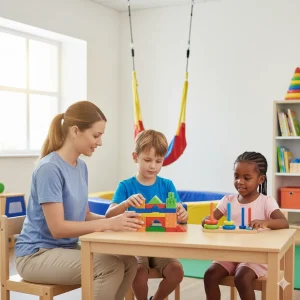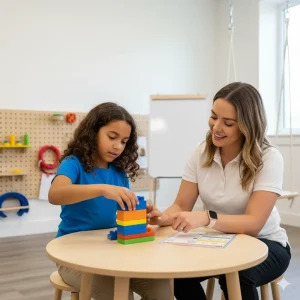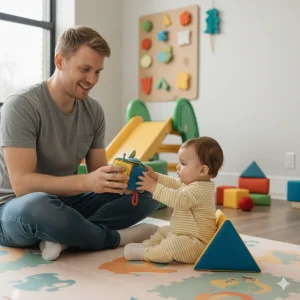How Occupational Therapy Helps Kids with ADHD: Benefits & Tips
By Prapoorna M
Last Updated: February 22, 2024
Imagine navigating a world where the simple act of focusing on a task feels like trying to catch a leaf in a whirlwind. This is often the reality for individuals living with Attention-Deficit/Hyperactivity Disorder (ADHD). A condition not just of childhood whimsy but one that stretches into the realms of adulthood, ADHD is characterized by a constellation of symptoms like inattention, hyperactivity, and impulsivity. These symptoms, often misunderstood, can significantly impact everyday life, from school to work and even in personal relationships.
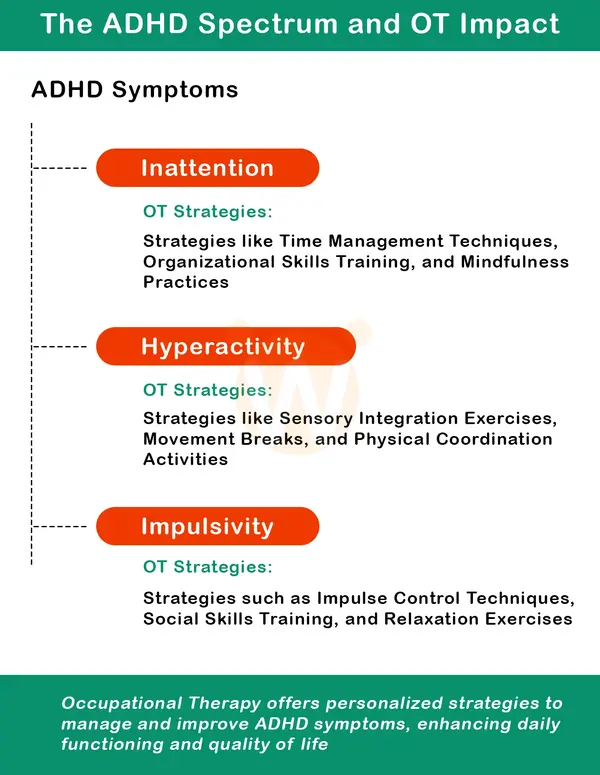
But what if there’s a key to unlock the true potential hidden within this whirlwind? Enter Occupational Therapy – a beacon of hope in the often turbulent seas of ADHD. Unlike traditional approaches that might focus solely on medication or behavioral management, Occupational Therapy delves deeper. It offers a personalized, skill-building journey that transforms challenges into stepping stones for success.
Also Read: What Mental Issues Do Students Face and Why?
Understanding ADHD
Unlocking the Mystery of ADHD
ADHD is not just about being hyperactive or easily distracted. It’s a complex neurodevelopmental disorder that manifests in three primary ways:
- Inattention: This isn’t just about difficulty paying attention. It’s about the challenge in sustaining focus, particularly on routine or less engaging tasks. Imagine trying to listen to a quiet voice in a noisy room – that’s what focusing can feel like for someone with ADHD.
- Hyperactivity: More than just excess energy, hyperactivity in ADHD can feel like an inner motor that won’t turn off, making it hard to stay still or relax. It’s like having your mind constantly buzzing with activity and ideas.
- Impulsivity: This involves making hasty actions without considering potential consequences. It’s like being in a car that accelerates without warning, making it challenging to slow down and think before acting.
Each of these symptoms can bring a unique set of challenges, both personally and socially. For instance, inattention might lead to missed deadlines at work or school, while impulsivity can strain interpersonal relationships.
The Role of Occupational Therapy in ADHD
A New Dawn with Occupational Therapy
After understanding the labyrinth of ADHD, the next step is to explore the guiding light of occupational therapy (OT). Think of OT as a toolbox filled with strategies and techniques tailored to help individuals with ADHD navigate their daily lives more effectively.
What is Occupational Therapy?
Occupational Therapy is much more than just a set of exercises. It’s a holistic approach that focuses on enhancing a person’s ability to perform everyday tasks despite the hurdles posed by ADHD. OT practitioners work closely with individuals to improve their:
- Organization Skills: They help in structuring tasks and environments to reduce distractions and improve focus.
- Time Management: OT introduces techniques to help individuals with ADHD prioritize tasks and manage their time more efficiently.
- Focus Improvement: By employing sensory integration techniques and tailored activities, OT aids in enhancing concentration levels.
In essence, Occupational Therapy isn’t about changing the person with ADHD to fit into the world; it’s about equipping them with the skills to navigate their world successfully. It’s a journey from chaos to control, from frustration to fulfillment.
Explore more on What are the therapies offered to Autistic patients? | Therapies of Autism
Techniques Used in Occupational Therapy for ADHD
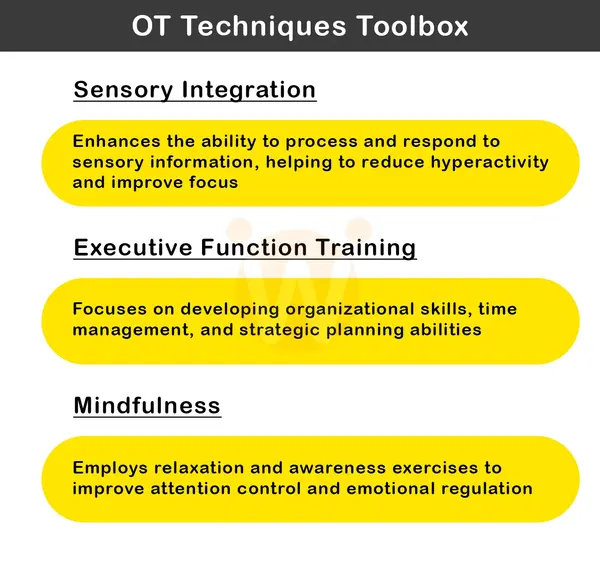
Crafting a Toolkit for Success
When it comes to managing ADHD, one size does not fit all. Occupational Therapy (OT) embraces this notion by offering a variety of techniques, each tailored to meet unique challenges. Let’s explore some of these innovative strategies:
Sensory Integration Exercises:
These exercises are designed to help individuals with ADHD better process and respond to sensory information. For instance, using tools like weighted blankets can provide a calming effect, while activities like playing with therapy putty can enhance focus.
Executive Function Training:
This includes exercises to improve planning, organization, and time management skills. Simple tools like digital planners or color-coded calendars can be game-changers in keeping daily tasks manageable and less overwhelming.
Mindfulness and Relaxation Techniques:
Techniques like guided meditation or breathing exercises are incorporated to help manage impulsivity and stress, leading to improved focus and decision-making.
Real-Life Impact: A Case Study
Imagine a young student, Alex, struggling with completing assignments on time due to ADHD. Through Occupational Therapy, Alex learned to use a digital planner for scheduling tasks. This simple tool, coupled with regular mindfulness exercises, helped Alex improve not just in academics but also in personal time management.
Read more about on Engaging Home-Based Occupational Therapy Activities for Children with Autism.
Personalized Approach in Occupational Therapy
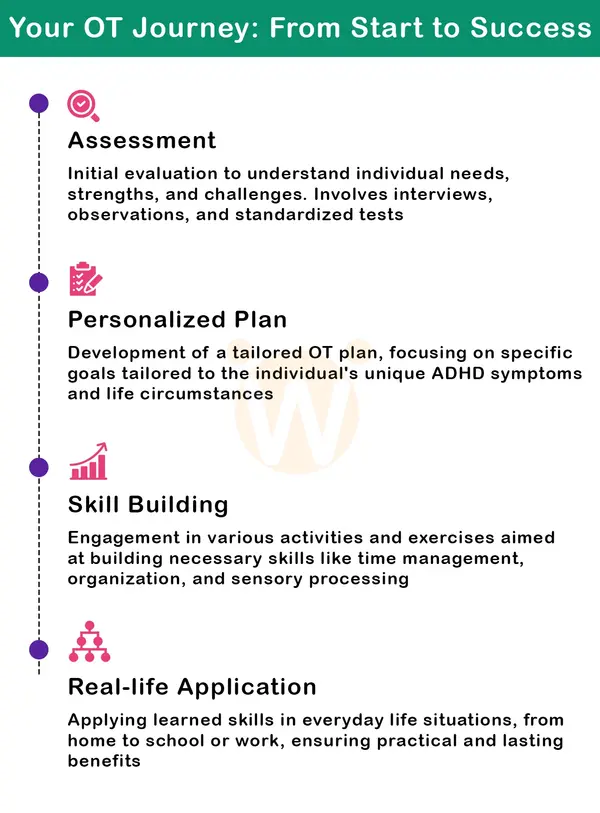
Tailoring the Journey to Each Individual
At the heart of Occupational Therapy for ADHD is the principle of personalization. No two individuals with ADHD are the same, and neither should be their therapy. Here’s where the expertise of therapists, like those at Wellness Hub, plays a crucial role.
Wellness Hub: A Personal Touch
At Wellness Hub, our therapists understand that each journey is unique. They take the time to get to know each individual – their challenges, their strengths, their goals. This understanding forms the basis of a tailored therapy plan, which could include a mix of sensory exercises, executive function training, or even recommendations for environmental adjustments at home or work.
By focusing on the individual, Occupational Therapy goes beyond just managing symptoms; it empowers each person to harness their strengths and navigate their world more effectively.
Also Read: The Crucial Role of Parents in Online Speech Therapy
Occupational Therapy Beyond the Clinic
Embracing Flexibility with Online and At-Home Therapy
Occupational Therapy for ADHD is not confined within the four walls of a clinic. In our digital age, therapy has transcended traditional boundaries, bringing support right to your doorstep or screen. Let’s dive into how OT is adapting to our increasingly connected world.
The Rise of Online Occupational Therapy
Online OT sessions have become a beacon of flexibility and accessibility for many. Through video calls, therapists can guide individuals with ADHD in real time, offering personalized strategies and exercises. This approach is particularly beneficial for those who may find it challenging to travel to a clinic due to time constraints, geographical barriers, or comfort preferences.
Integrating Technology in Therapy
Technology, when used wisely, can be a powerful ally in Occupational Therapy for ADHD. Digital tools and apps are becoming increasingly popular in OT for several reasons:
- Interactive Apps for Skill Building: Apps designed to enhance focus, memory, and organizational skills can be integrated into therapy sessions. They turn exercises into engaging activities, making skill-building enjoyable and effective.
- Digital Planners and Calendars: These tools aid in structuring daily routines, setting reminders, and breaking down tasks into manageable steps. They are especially useful for individuals struggling with time management and organization.
- Virtual Sensory Tools: For those who benefit from sensory integration exercises, there are digital platforms offering virtual sensory rooms, auditory support like white noise or ambient music, and visual relaxation experiences.
Read more about: Is Online Speech Therapy Effective? A Comprehensive Overview
Practical Tips and Strategies in Occupational Therapy for ADHD
Transforming Challenges into Achievements
Occupational Therapy (OT) is not just about understanding the theory; it’s about putting it into practice. For individuals with ADHD, applying practical strategies in everyday life can make a significant difference. Here are some actionable tips and simple exercises you can try at home, which OT often teaches to improve organization, time management, and focus.
- The Power of Routine:
Establishing a routine can be a game-changer. Start by setting specific times for regular activities like meals, work, and relaxation. Consistency helps in reducing the anxiety of unpredictability, which is often a challenge in ADHD. - Break It Down:
When faced with a task, break it down into smaller, more manageable steps. This approach prevents feeling overwhelmed and makes it easier to start and complete tasks. - Visual Reminders:
Use visual cues like sticky notes, colored markers, or digital reminders for important tasks and deadlines. These act as constant, gentle nudges to stay on track. - Mindfulness Moments:
Incorporate brief mindfulness exercises into your day. Even a few minutes of deep breathing or meditation can significantly enhance focus and reduce impulsivity. - Sensory-Friendly Spaces:
Create a sensory-friendly environment at home or work. This could mean having a quiet, clutter-free space or using items like stress balls or fidget tools to help maintain focus. - Technology to the Rescue:
Embrace technology by using apps for time management, digital calendars for scheduling, or brain training games to improve cognitive functions. - Physical Activity:
Regular physical activity, even a short walk or stretching, can greatly improve concentration and reduce restlessness associated with hyperactivity. - Celebrate Small Victories:
Recognize and celebrate small accomplishments. This practice builds confidence and motivation, reinforcing positive behaviors.
Here are some actionable tips and simple exercises you can try at home
Finding the Right Occupational Therapist
Your Guide to Choosing the Perfect OT Partner
Embarking on the journey of Occupational Therapy (OT) for ADHD can be transformative, but it starts with finding the right therapist. Here are some tips to help you choose an OT who can best support your unique needs:
- Look for Specialization: Ensure the therapist has experience and training in ADHD. A therapist who understands the nuances of ADHD can offer more tailored strategies.
- Check Credentials: Verify their qualifications, certifications, and licensure. A qualified OT should have the necessary training and credentials to provide professional care.
- Consider Compatibility: Therapy is a partnership. Choose a therapist whose approach and personality align with your preferences and comfort.
- Ask About Their Methods: Inquire about the techniques and tools they use. It’s important that their approach resonates with your needs and goals.
- Seek Recommendations: Personal recommendations or testimonials can be valuable. Hearing about others’ experiences can give insights into what to expect.
Read more on How to find the right autism therapy center for my child.
Choosing the Right OT: Checklist
| Criteria | Description | Why It’s Important |
|---|---|---|
| Specialization | The OT should have specialized experience and training in managing and treating ADHD. | Tailored strategies ensure that the therapy is specifically designed to address the unique challenges of ADHD, leading to more effective outcomes. |
| Credentials | The OT should possess the necessary certifications and licensure to practice occupational therapy. | Proper credentials ensure that the therapist meets professional standards and is qualified to provide safe and effective care. |
| Approach | The therapeutic approach and methods used by the OT should align with the patient’s needs and goals. | Compatibility in the therapeutic approach enhances the effectiveness of therapy, as it ensures the patient’s comfort and engagement in the therapeutic process. |
| Experience | Consider the OT’s overall experience, particularly in working with ADHD patients. | Experienced therapists bring a depth of knowledge and a range of effective strategies, having worked with various ADHD cases. |
| Communication Style | The OT’s ability to communicate clearly and effectively with the patient. | Good communication is essential for understanding patient needs, explaining strategies, and ensuring that therapy goals are met effectively. |
| Location & Accessibility | The convenience of the therapist’s location and the availability of sessions (in-person or online). | Easy access to therapy without excessive travel or inconvenience is crucial, especially for consistent, long-term treatment plans. |
| References & Reviews | Feedback from previous or current clients, either through direct references or online reviews. | Client testimonials can provide insights into the therapist’s effectiveness and patient satisfaction, helping to gauge the likely quality of care. |
Beyond Occupational Therapy – Comprehensive ADHD Management
Embracing a Holistic Approach to ADHD
Managing ADHD effectively often requires a multi-faceted approach. While Occupational Therapy plays a pivotal role, it’s part of a larger picture that includes other treatment options:
- Medication: Medication can be an effective way to manage some of the core symptoms of ADHD. Stimulants are commonly prescribed, but non-stimulant options are also available.
- Behavioral Therapy: This involves working with a therapist to develop strategies to change certain behaviors. It’s particularly effective in children and can involve parents and teachers.
- Lifestyle Changes: Simple changes in diet, exercise, and daily routines can significantly impact ADHD symptoms. Regular physical activity and a balanced diet can help improve focus and reduce hyperactivity.
- Support Systems: Building a support network, whether through family, friends, or support groups, is vital. Sharing experiences and strategies can provide invaluable support and encouragement.
Also Read: Things that Make Modern Performance Management Effective
Comparing Traditional ADHD Treatments with OT
| Treatment Type | Focus Area | Benefits |
|---|---|---|
| Medication | Symptom Management | – Provides quick relief from core ADHD symptoms like inattention, hyperactivity, and impulsivity. – Can improve immediate focus and behavior. – Effective for a wide range of patients. |
| Behavioral Therapy | Behavior Modification | – Aims to change negative behaviors into positive ones.<br>- Teaches coping skills and strategies for managing everyday challenges. – Involves parents and teachers in children’s treatment plans for a more integrated approach. – Offers long-term benefits in managing ADHD. |
| Occupational Therapy | Skill Development | – Focuses on developing practical life skills. – Tailors strategies to individual needs, enhancing daily functioning. – Addresses challenges in organization, time management, and focus. – Encourages holistic improvement in both personal and professional life. – Includes sensory integration, executive function training, and other unique techniques. |
Conclusion
OT provides tailored techniques to enhance focus, organization, and time management, transforming the challenges of ADHD into opportunities for growth and achievement. It’s a journey that redefines limitations, empowering individuals to lead fuller, more engaged lives. As we close this discussion, remember that Wellness Hub is here to support this journey.
Our resources, expert therapists, and welcoming community offer a nurturing environment for anyone seeking to navigate ADHD with confidence and positivity. Visit us at Wellness Hub to discover more and take your first step towards embracing your full potential. Your story with ADHD is unique, and with the right support, it can be a journey of empowerment and success.
Frequently Asked Questions:
1. What is Occupational Therapy (OT) for ADHD?
Occupational Therapy for ADHD involves personalized interventions aimed at improving daily functioning and managing symptoms such as inattention, hyperactivity, and impulsivity. OT provides strategies for better organization, time management, and focus.
2. How does Occupational Therapy help individuals with ADHD?
OT helps by offering practical techniques and tools to enhance focus, organization, and self-regulation skills. It includes sensory integration exercises, executive function training, and personalized activities designed to meet individual needs.
3. Can Occupational Therapy be done online for ADHD patients?
Yes, online Occupational Therapy is available and effective for ADHD patients. It includes virtual sessions with therapists and the use of digital tools and apps to support therapy goals.
4. What kind of activities are involved in Occupational Therapy for ADHD?
Activities can include sensory integration exercises, mindfulness practices, use of digital planners for time management, task breakdown strategies, and exercises to improve physical coordination.
5. Is Occupational Therapy suitable for all ages with ADHD?
Occupational Therapy is beneficial for individuals with ADHD of all ages, from children to adults. The strategies and activities are tailored to suit the age and specific challenges of each individual.
6. Can Occupational Therapy for ADHD be combined with other treatments?
Yes, OT is often part of a comprehensive treatment plan that can include medication, behavioral therapy, and lifestyle changes like diet and exercise.
7. How do I find a qualified Occupational Therapist for ADHD?
You can find qualified therapists through professional associations, healthcare providers, or platforms like Wellness Hub, which connects you with experienced Occupational Therapists specializing in ADHD.
8. What are the benefits of Occupational Therapy for managing ADHD?
The benefits include improved time management, enhanced focus and concentration, better organization skills, reduced impulsivity, and overall improved daily functioning and quality of life.
9. How long does it take to see results from Occupational Therapy for ADHD?
The time to see results can vary depending on the individual’s commitment to therapy and the complexity of their symptoms. However, many start to see improvements within a few weeks of consistent therapy.
10. Can Occupational Therapy help with ADHD-related school or work challenges?
Absolutely. OT provides strategies and tools that are particularly effective in addressing ADHD-related challenges in academic and professional settings, such as staying organized, meeting deadlines, and maintaining focus.
About the Author:
Prapoorna Mangalampalli
M.Sc., M.A., (Dual Masters in Psychology & English) – Counselor (6+ years of experience)
Prapoorna armed with a passionate dedication fueled by dual Master’s degrees in Psychology and English, Prapoorna sheds light on and elevates human experiences. Over 6+ years of experience fuel her insightful approach to counseling, offering profound empathy and guidance across diverse areas like online, marital, relationship, child, family, and career counseling. Her specialized training in various counseling sectors further underscores this dedication to empowering positive change.
Currently, at Wellness Hub, she thrives in a team environment that values innovation, compassion, and achieving results for their clients.
Connect with Prapoorna to learn more about how she can help you or your loved one find their voice and build a brighter future.
Book your Free Consultation Today
Parent/Caregiver Info:
Client’s Details:
* Error Message


